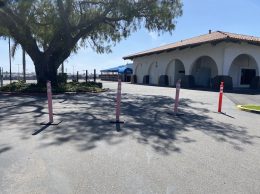
Philip Joens
A Cal Poly Technology Park company is helping drivers drive better by giving them feedback.
Several apps developed by Mentor eData track how well users drive and give them scores at the end of their trips.
Stephen Lakowske founded the company in 2009 when his two teenage daughters approached driving age.
“I thought ‘holy smokes, this is scary!’” Lakowske said. “I’d been in aviation for my whole career and thought about the way we train people in aviation.”
Lakowske previously owned an aviation simulator company in Boulder, Colo. He designed apps for smartphones to give drivers the same analytical feedback about drives that flight simulators give pilots about flights.
About 26 million people use Mentor eData apps. Driving Buddy was the earliest Lakowske created.
Lakowske said he thought insurance companies would be interested in his app. They are, but not because they want to improve customers’ driving habits. Rather, insurance companies want to know how poorly their customers drive.
Because credit scores determine in large part what customers pay for car insurance, Mentor eData partnered with credit scoring company FICO to develop driving scores insurance companies can use as well.
Several driving schools in the region use the Driving Buddy app to assess students’ drives. Parents can also use the app to track how well their children drive.
I used Driving Buddy for two weeks to see how it worked.
Driving Buddy tracks basic things like distance, duration and destinations of trips. It uses sensors like accelerometers and magnetometers to track how many turns users make and how many times users start and stop. Impressively, it also tracks if users make hard turns, break hard or handle their cars poorly.
Lakowske said most middle-aged Americans think they’re perfect drivers, so the target demographics are student drivers. Surprisingly, senior citizens also love the app.
“AARP is just over the moon about it,” Lakowske said. “They already have classroom-type services, but now you get to see and assess how you are behind the wheel.”
Anyone who’s ever ridden with me knows I drive more like my grandma Doris than Dale Earnhardt Jr. I try to drive the speed limit every time. Slow and steady, get there alive has always been my attitude on the road — unlike most Californians.
So it surprised me when the app told me I was a worse driver than I thought I was. The app generates a score on a scale from one to 1,000 based on how well a driver performed.
Driving Buddy told me I made three aggressive left turns and stopped aggressively once during a 28-mile trip from Santa Barbara to Ventura on Feb. 16. The app also illustrated a bigger point to me the next day.
Usually my phone sits in my armrest when I drive. On Feb. 17, I called my mom in Iowa as I got off work and walked to my car. I decided to talk to her using a Bluetooth headset as I drove home to Ventura because bumper-to-bumper traffic at 5:30 p.m. on Highway 101 is terrible, boring and I drive in it every day.
Lakowske designed the app to track when calls and texts are received and answered. If sudden accelerations happen and handling worsens after a text is received, you can assume the driver looked at that text. Data from trips cannot be seen until after a car is parked, at which point it takes one second for Mentor eData’s servers to analyze the results.
My mom hung up when I pulled into my parking spot and the first thing I saw was a score of just 403, well below my average of 695. During the trip I made three aggressive left turns. My handling score of 687 fell below my average of 726 and I had sped eight times.
Thanks to Driving Buddy, I finally understood. Don’t use your phone while driving.
• Contact Philip Joens at pjoens@pacbiztimes.com.






 Print
Print Email
Email

















